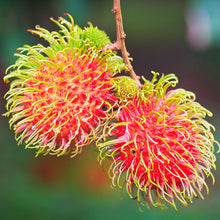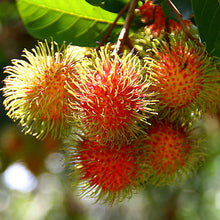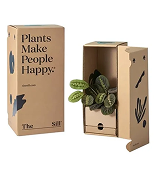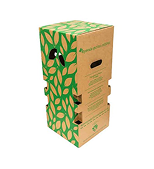- Home
- Outdoor Plants
- Rambutan Fruit - Fruit...
Rambutan Fruit - Fruit Plants & Tree







Rambutan Fruit - Fruit Plants & Tree

 Climate
Climate Time to yield
Time to yield Maximum size
Maximum size


Damaged or lifeless? We’ll replace it for free. Learn more




Double layered custom boxes to protect plants during shipping.

Air vents for proper air-flow

To preserve plant freshness during transit

Details steps of how to grow and maintain your plant
Rambutan is botanically known as Nephelium lappaceum from the family Sapindaceae. The name also refers to the edible fruit produced by this tree. The rambutan is native to Southeast Asia. It is closely related to several other edible tropical fruits including the litchi, longan, pulasan, and mamoncillo. It produces fruits in clusters of long thick, soft, hairs or spines on the surface. The hairy outgrowth has eye-catching red and yellow colors and it imparts a distinctive exotic appearance to its fruits. The fruits are a good source of sugars and vitamin C and are eaten as a fresh dessert fruit.
Description
Rambutans are small, oval to round fruits, averaging 3 to 5 centimeters in diameter, and grow in loose, hanging clusters of 10 to 20 fruits. The fruits are enveloped in a semi-thick, firm, and leathery rind, covered in soft, spine-like protrusions known as spinterns. Underneath the rind, the flesh varies from white, translucent, to pale pink and is succulent and slightly chewy, encasing a central, oblong, light brown seed wrapped in thin, papery layers. Rambutans are aromatic and have a sweet, fruity flavor with mild acidity, containing subtle notes of strawberries and grapes.
Seasons/Availability
Rambutans are available seasonally, depending on the region, and are generally found in the fall and winter. In tropical areas of Southeast Asia, the trees fruit twice a year.
Current Facts
The name Rambutan is derived from the Malaysian word “rambut,” translating to mean “hair,” and is a descriptor given for the fruit’s hairy, spine-like appearance. Rambutan cultivation is globally increasing as the fruits are valued for fresh eating, desserts, and flavoring beverages. The trees are prolific, producing hundreds of fruits in a season. Rambutan trees are considered an ornamental variety, valued for their color contrast between the bright fruits and dark green leaves.
MAXIMUM HEIGHT - It can grow up to 8-12 meters tall.
BLOOMING YEAR - Generally blooms in spring & monsoon seasons.
FRUITING YEAR - It starts fruiting after 3-4 years after planting.
GROWING TIPS -
- You can grow it in the bigger growing bag, but planting directly in the ground will be great for the plant.
- It can grow almost in all types of soil, but the soil should be well-drained, fertile, and organic in nature.
- It needs a minimum of 4-6hours of direct sunlight area, even though it can tolerate up to 5 Degree celsius temperature.
- It loves to grow in all tropical & subtropical climates.
- Provide basin around the plant, for better utilization of the water & fertilization.
- You can add organic or homemade compost once in 3 months.
INSIDE THE BOX
-
S.No. PRODUCT NAME DIMENSION 1. Rambutan Fruit Plant 1-2 Feet Height 2. Growing Pot (Black color) 6 Inch *above specifications are for indicative purposes only, actual dimensions may slightly vary.
PLANT CARE
LIGHT CONDITION - It requires a minimum of more than 4 hours of Direct Sunlight.
WATERING SCHEDULE - Water when the topsoil(2-3 inches) feels dry to touch. Always maintain moisture near the root zone.
SOIL TYPE - The soil should be well-drained, fertile & rich in organic content.
FERTILIZER APPLICATION - Apply any organic fertilizer once three months for better health of the plant, apply water immediately after fertilizer application.
PLANT PROTECTION - Do regular pruning of the plant in order to maintain good required shape. Remove dead, infected, or damaged plant parts and discard them away from the plants.
INITIAL CARE FOR 10-15 DAYS JUST AFTER RECEIVING YOUR PLANT
- Remove the Packaging Materials carefully.
- Press the soil in the pot & add additional soil(garden mix) if necessary.
- Maintain moisture in the pot, Do not overwater it may kill your plant, so make sure that the soil should be dry between watering.
- Provide support with stick/moss stick(vine plant) in order to make straight growth, for needed plant only.
- Make sure that plants get enough morning direct bright light for 10-15 days & do not go for immediate transplanting(minimum 1 month)
- Just prune if any branch of the plant is get damaged in transit.
Selected plant of 8-10 inches
Planted into a 5-inch pot
With healthy, moisture-retaining soil
A care instruction sheet for maintenance guide

Get in touch for best pricing on bulk orders and landscaping projects.
 WhatsApp us
WhatsApp us

Call on 9177805454 (Mon-Sat, 9 AM-6 PM) or WhatsApp us – we’re here to help.
About Exotic Flora
At Exotic Flora, we’re passionate about bridging the gap in bringing plants to everyone. With over 500+ varieties across 7 plant categories, from exotic finds to everyday greens, we bring the entire range to you.
Our plants, sourced from all parts of India are nurtured at Kadiyam, in our 25 acres in-house nursery by a team of expert horticulturists. Once they are ready we ship all our plant varieties across India.
Our services go beyond safe delivery of plants. A dedicated support team is there to help you with any maintenance queries you may have.
At Exotic Flora we always believe in going that extra mile, because everyone should have the plants they love.
Every, fruit plants vary in their fruiting time, depends on location, climate & age of the plants. Generally, Grafted fruit plants starts fruiting within 2 years of planting, where as non-grafted plants take more than 2 years. You can check the fruiting time of each plant in the plant description.
No, Majority of fruit plants are not delivered with fruits. But some grafted fruit plants can be delivered with fruits and flowers mostly Citrus, Guava, Star fruit, Fig, Ber etc. But it is recommended to remove the flowers during early days, so that plants can get more branches and physical strength.
Grafting is a technique where two plants part are combined together so that they can grow together. Most commonly seen in Mango. Air Layering is also a vegetative propagation technique where a plant is produced while it is still attached to its parent's plants. Commonly seen in Guava. Stem cutting is a vegetative propagation technique, where soft, semi-hard, or hardwood stem is cut with 2-3 nodes and used for the multiplication of plants. Commonly seen in flowering & ornamental plants.
Yes, the grafted fruit trees produce fruit earlier, than the non-grafted fruit plants.
These are some of the rare and new fruit plants and it's varities, which are not avialable everywhere in our country.
Remove the plant from its pot. Make sure to not disturb the root ball. Place the plant in a prepared pit(1x1ft) or slightly bigger pot than the current pot. Firm the soil around the plant with your hands. Water well till it drains out from the drainage hole.
In order to maintain the good shape of the plants, proper care should be taken from the beginning like the pruning of unwanted and diseased parts of plants, stalking to young plants, regular maintenance of plants.
In General, a grafted/air layered/hybrid fruit takes 2 years for fruiting, whereas seeded grown plants take 4-5 years of time for fruiting. But it may vary depending on the plant types.
In general if your soil weell drained, fertile and organic in nature, it will produce good quality fruit. Sandy-loamy is the most preferable soil used for fruit plants.
Size and taste of each fruit plants varies depending on the varieties. You can find more details about each fruit plants in terms of size and taste in the description of individual plants.
Initial first 2 years are very important to feed the plants with organic manure and fertilizers regularly. It is recommended to add organic manure or compost to each plant in every 3 months of time intervals. Do not go for Chemical fertilizers it will weaken the plants in future.
Plastic pots with drainage holes preferably work best as they are lighter to move around. Any other container which is light in weight with a drainage hole can also work to grow fruit plants.
